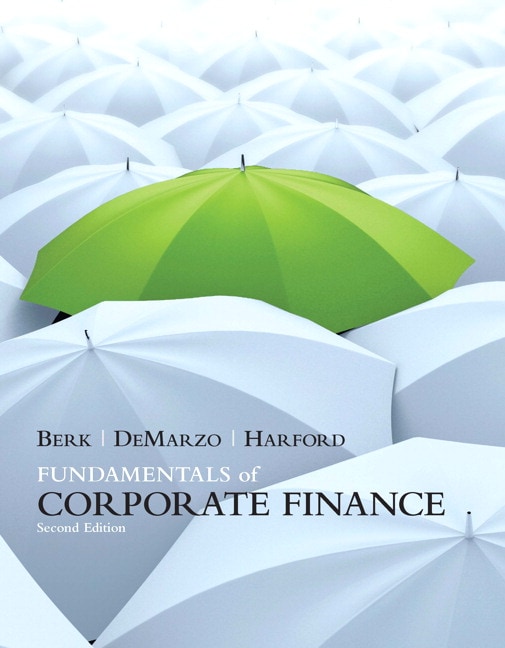2020. 2. 29. 16:36ㆍ카테고리 없음
.Corporate Finance, 4th Edition. DescriptionFor MBA/graduate students taking a course in corporate finance.This package includes MyFinanceLab ™.An Emphasis on Core Financial Principles to Elevate Individuals’ Financial Decision MakingUsing the unifying valuation framework based on the Law of One Price, top researchers Jonathan Berk and Peter DeMarzo have set the new canon for corporate finance textbooks.
Personalize learning with MyFinanceLab TMMyFinanceLab is an online homework, tutorial, and assessment program designed to work with this text to engage students and improve results. Within its structured environment, students practice what they learn, test their understanding, and pursue a personalized study plan that helps them better absorb course material and understand difficult concepts. NEW!
Auto-Graded Excel Projects use proven, field-tested technology, allowing instructors to seamlessly integrate Excel problems into their course. End-of-chapter problems. The values in the problems are algorithmically generated, giving students many opportunities for practice and mastery. Problems can be assigned by professors and completed online by students. Helpful tutorial tools, along with the same pedagogical aids from the text, support students as they study. Links to the eText direct students to the material they most need to review.

Interactive Figures. Select in-text graphs and figures that cover topics such as bonds, stock valuation, NPV, and IRR have been digitally enhanced to allow students to interact with variables to affect outcomes and bring concepts to life. Video clips cover high-profile firms such as Boeing, Cisco, Delta, and Intel through interviews and analysis. The videos focus on core topical areas, including capital budgeting, mergers and acquisitions, and risk and return.
Finance in the News provides weekly postings of a relevant and current article from a newspaper or journal article with discussion questions that are assignable in MyFinanceLab. Live news and video feeds from The Financial Times and ABC News provide real-time news updates. Author Solution Videos walk students through the in-text examples using math, the financial calculator, and spreadsheets. UPDATED! HTML5 Player. In addition to matching the Flash player’s support of Accessibility requirements, the HTML5 player has a new “Show Work” feature to allow students to enter text either from a keyboard or stylus and to draw freehand on different backgrounds, such as a coordinate graph, with multiple fonts and colors.
Students can also continue to upload images such as phone photos of handwritten work. Printing enhancements include:. a more pen-and-paper-friendly layout of exercises.
the ability for instructors to choose whether to print the header; to include an honor statement; and to print with answers in line, after each question, or on a separate sheetAbout the BookMethodology that Connects Theory to Practice. The Law of One Price: A Unifying Principle of Valuation. The Law of One Price is used as a framework, reflecting the modern idea that the absence of arbitrage is the unifying concept in valuation. This theme is explicitly introduced in Chapter 3, revisited in each Part Opener, and integrated throughout the text-motivating all major concepts. This methodology directly connects theory to practice, and unifies what might appear to students as disparate topics that comprise the course syllabus (corporate finance, investments, and valuation).
Options for Teaching Risk and Return. Chapter 3 briefly introduces the concept of risk and return.
Using the no-arbitrage concept, the reasoning behind evaluating risk relative to a benchmark is explained conceptually and allows for use of the concept of risk and return in early chapters. Later, the structure of Part IV is flexible and allows instructors to opt for brief or comprehensive coverage of the topic. Emphasis of Capital Budgeting and Valuation.
Capital budgeting and valuation is presented in two distinct stages. The first, which appears in Chapter 8, focuses on cash flows, while the second stage focuses on capital budgeting and valuation in the real world in Chapter 18 and the capstone Chapter 19.Learning Aids that Teach Students to ‘Think Finance’.
A Simplified Presentation of Mathematics. One of the hardest parts of learning finance is mastering the jargon, math, and non-standardized notation. Corporate Finance systematically uses:.
Notation Boxes: Each chapter opens by defining the variables and acronyms used in the chapter as a 'legend' for students' reference. Timelines: Introduced in Chapter 4, timelines are emphasized as the important first step in solving every problem that involves cash flows.
Corporate Finance Berk
Numbered and Labeled Equations: The first time a full equation is given in notation form it is numbered. Personalize learning with MyFinanceLab TMMyFinanceLab is an online homework, tutorial, and assessment program designed to work with this text to engage students and improve results.
Within its structured environment, students practice what they learn, test their understanding, and pursue a personalized study plan that helps them better absorb course material and understand difficult concepts. Auto-Graded Excel Projects use proven, field-tested technology, allowing instructors to seamlessly integrate Excel problems into their course. UPDATED!
HTML5 Player. In addition to matching the Flash player’s support of Accessibility requirements, the HTML5 player has a new “Show Work” feature to allow students to enter text either from a keyboard or stylus and to draw freehand on different backgrounds, such as a coordinate graph, with multiple fonts and colors. Students can also continue to upload images such as phone photos of handwritten work. Printing enhancements include:. a more pen-and-paper-friendly layout of exercises.
the ability for instructors to choose whether to print the header; to include an honor statement; and to print with answers in line, after each question, or on a separate sheetAbout the BookCoverage of The Latest Developments in the Field. UPDATED!
Focus on the 2007—2009 Financial Crisis and Sovereign Debt Crisis. Twenty-two Global Financial Crisis boxes reflect the reality of the recent financial crisis and ongoing sovereign debt crisis, noting lessons learned.
Boxes across the book illustrate and analyze key details. Applications that Reflect Real Practice. Corporate Finance features actual companies and leaders in the field:. Six interviews with notable practitioners highlight leaders in the field and address the effects of the financial crisis and ongoing European sovereign debt crisis. Nobel Prize boxes reflect recent Nobel prizes awarded for material covered in the book.Specific Content Changes. Material that addresses the implications of negative interest rates has been added throughout the book.
Coverage describes the ongoing changes to how stocks are traded worldwide. Also, the Dodd-Frank Act information has been updated and a new interview with M. Table of ContentsPART 1: INTRODUCTION1. The Corporation2.
Introduction to Financial Statement Analysis3. Financial Decision Making and the Law of One PricePART 2: TIME, MONEY, AND INTEREST RATES4. The Time Value of Money5. Interest Rates6. Valuing BondsPART 3: VALUING PROJECTS AND FIRMS7. Investment Decision Rules8.
Fundamentals of Capital Budgeting9. Valuing StocksPART 4: RISK AND RETURN10. Capital Markets and the Pricing of Risk11. Optimal Portfolio Choice and the Capital Asset Pricing Model12.

Estimating the Cost of Capital13. Investor Behavior and Capital Market EfficiencyPART 5: CAPITAL STRUCTURE14. Capital Structure in a Perfect Market15. Debt and Taxes16. Financial Distress, Managerial Incentives, and Information17.
Payout PolicyPART 6: ADVANCED VALUATION18. Capital Budgeting and Valuation with Leverage19. Valuation and Financial Modeling: A Case StudyPART 7: OPTIONS20. Financial Options21. Option Valuation22. Real OptionsPART 8: LONG-TERM FINANCING23. Raising Equity Capital24.
Debt Financing25. LeasingPART 9: SHORT-TERM FINANCING26. Working Capital Management27.
Short-Term Financial PlanningPART 10: SPECIAL TOPICS28. Mergers and Acquisitions29. Corporate Governance30. Risk Management31. International Corporate Finance. About the Author(s)Jonathan Berk is the A.P. Giannini Professor of Finance at the Graduate School of Business, Stanford University and is a Research Associate at the National Bureau of Economic Research.
Before coming to Stanford, he was the Sylvan Coleman Professor of Finance at Haas School of Business at the University of California, Berkeley. Prior to earning his Ph.D., he worked as an Associate at Goldman Sachs (where his education in finance really began).Professor Berk’s research interests in finance include corporate valuation, capital structure, mutual funds, asset pricing, experimental economics, and labor economics. His work has won a number of research awards including the TIAA-CREF Paul A.
Samuelson Award, the Smith Breeden Prize, Best Paper of the Year in The Review of Financial Studies, and the FAME Research Prize. His paper, “A Critique of Size-Related Anomalies,” was selected as one of the two best papers ever published in The Review of Financial Studies. In recognition of his influence on the practice of finance he has received the Bernstein-Fabozzi/Jacobs Levy Award, the Graham and Dodd Award of Excellence, and the Roger F. Murray Prize.He served as Associate Editor of the Journal of Finance, Director of the Western Finance Association, Academic Director of the Financial Management Association, is a Fellow of the Financial Management Association, and is a member of the advisory board of the Journal of Portfolio Management.Born in Johannesburg, South Africa, Professor Berk is married, with two daughters, and is an avid skier and biker.Peter DeMarzo is the Mizuho Financial Group Professor of Finance and current Vice President of the American Finance Association. He is also a Research Associate at the National Bureau of Economic Research.

He currently teaches MBA and Ph.D. Courses in Corporate Finance and Financial Modeling. In addition to his experience at the Stanford Graduate School of Business, Professor DeMarzo has taught at the Haas School of Business and the Kellogg Graduate School of Management, and he was a National Fellow at the Hoover Institution.Professor DeMarzo received the Sloan Teaching Excellence Award at Stanford, and the Earl F. Cheit Outstanding Teaching Award at U.C. Berkeley.Professor DeMarzo has served as an Associate Editor for The Review of Financial Studies, Financial Management, and the B.E.
Journals in Economic Analysis and Policy, as well as a Director of the American Finance Association. He has served as Vice President and President of the Western Finance Association. Professor DeMarzo’s research is in the area of corporate finance, asset securitization, and contracting, as well as market structure and regulation. His recent work has examined issues of the optimal design of contracts and securities, and the influence of information asymmetries on stock prices and corporate investment. He has received numerous awards including the Western Finance Association Corporate Finance Award and the Barclays Global Investors/Michael Brennan best-paper award from The Review of Financial Studies.Professor DeMarzo was born in Whitestone, New York, and is married with three boys.